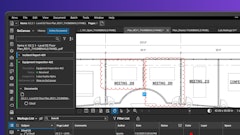In a survey of architecture, engineering and construction (AEC) professionals, the most common prediction about the industry's future technology use -- 65.3% of respondents say -- is that virtual reality applications will be employed much more to experience a building’s design before it is built.
ARC Document Solutions, Inc. (ARC), a document and information-management solutions provider to the AEC industry, says its survey reveals participants’ views on emerging technologies, also including Big Data, drones and the so-called “Internet of Things” (IoT).
Virtual reality in the construction industry is characterized by the creation and use of three-dimensional computerized modeling. Such models are used to facilitate project management, detect problems before actual construction occurs, design workflow sequencing, and to improve client interactions. The top benefits of virtual reality cited were:
- Projects will be easier to visualize (51.9%)
- Projects will be completed faster (48.3%)
- Projects will require fewer workers (42.2%)
- Projects will require less material (40.8%)
Another top technology trend, identified by 61.9% of the respondents, is the growing use of drones for surveying and for photo and video documentation. More than 60% (60.5%, specifically) recognized drones’ ability to help with mapping and surveying, inspection and creating image-based records as their primary benefits. Close to half (49.7%) of the participants named improved surveillance and safety as the top benefit of drone use by AEC professionals.
Most AEC professionals predicted that the adoption of these new virtual reality and drone technologies will occur in the near future, with 64% stating that they are likely to be in common use within the next five to 10 years.
According to survey findings, the future of the AEC industry will also be characterized by the absence of paper (38.1%) and the use of virtual technology to address not only two-dimensional drawing and three-dimensional modeling but also for project sequencing, cost estimating, sustainability and facilities management, often referred to as a “7D” building process. While technology clearly has a dominant role in industry trends, only 4.8% of participants predicted that robots will replace workers in the future.
Over half (57.8%) predicted that design and development will become paperless in the next two to five years. Asked to identify the main reason behind the elimination of paper in the AEC industry, respondents named these factors:
- Mobile/tablet technologies have replaced printed sets of drawings (43.5%)
- The Building Information Model (BIM) helps design and construction teams resolve building problems without having to print numerous drawings (27.2%)
- Project teams are more environmentally conscious (25.2%)
It is widely believed that removing paper in the industry will help diminish project over-runs. This was confirmed by survey respondents, who noted several beneficial results of reducing paper use, including:
- Better communication between workers (58.5%)
- Outdated data will no longer be shared (55.8%)
- Changes will be easier to see as they are made (54.4%)
The AEC industry will also see increased use of IoT. According to ARC’s survey, the top benefit of IoT (defined as a network of physical objects or “things” embedded with electronics, software, sensors and network connectivity) will be to enable the collection and exchange of data on a jobsite. It will help industry professionals by:
- Improving onsite/offsite equipment management (68.8%)
- Pinpointing the reason behind a delay (50%)
- Giving clear indicators of a project delay (31.3%)
Big Data is also very prominent on the AEC industry’s radar. The top advantages of Big Data, according to the respondents, are to help improve planning and decision-making by providing granular, real-time data about utilization and usage patterns, enabling project leaders and owners to improve demand forecasts as well as their future project progress monitoring. Top Big Data benefits mentioned by survey participants are the potential to:
- Facilitate well-informed decision-making on a consistent basis (62.5%)
- Improve urban planning decisions (50%)
- Create reports on construction operations frequently and in real time (43.85%)
“The survey results confirm what we’re already seeing across this enormous and influential industry. Transformative technological change is well under way, and its adoption will only accelerate in the future,” said K. “Suri” Suriyakumar, Chairman, President and CEO of ARC Document Solutions. “These technologies will bring unprecedented collaboration, coordination and connectivity in the AEC industry, increasing efficiency, bringing down costs, and making the industry more competitive.”




![[Video] Leica Geosystems and Milrem AS Team Up for World's First All-terrain Mobile Mapping UGV](https://img.forconstructionpros.com/files/base/acbm/fcp/image/2016/07/default.5788eb2ea4bad.png?auto=format%2Ccompress&fit=crop&h=167&q=70&w=250)
![[Video] Gilbane Shares How to Build an Immersive Presence with Virtual Reality](https://img.forconstructionpros.com/files/base/acbm/fcp/image/2016/04/default.57164d070847b.png?auto=format%2Ccompress&fit=crop&h=167&q=70&w=250)












